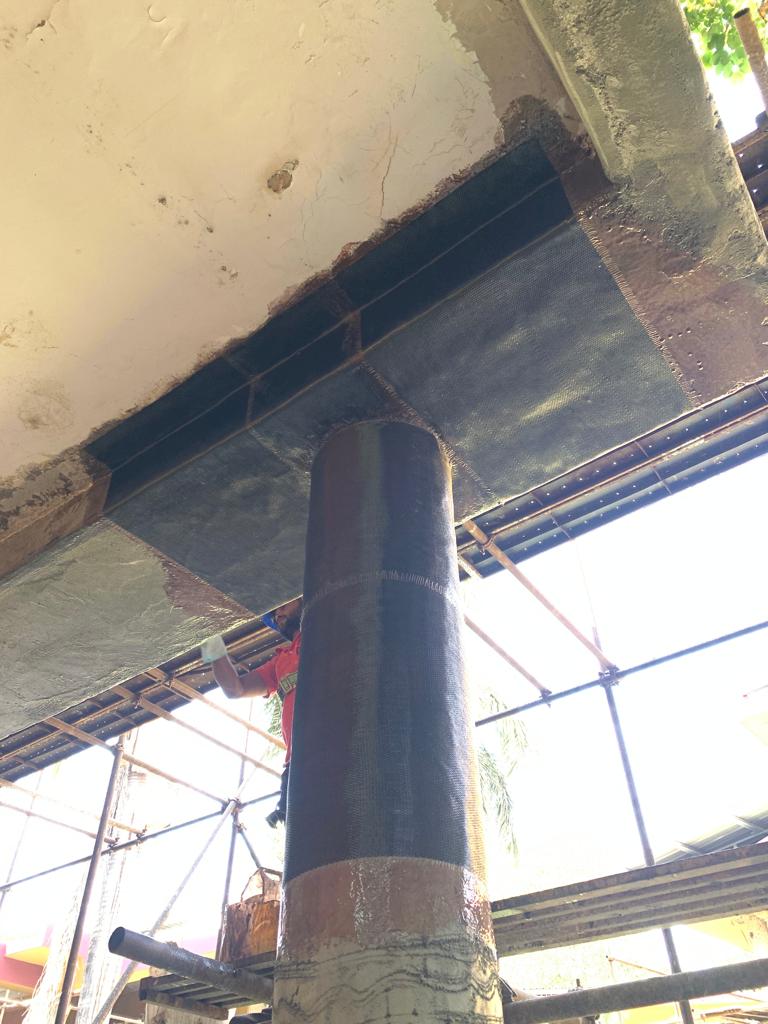
Column strengthening is a structural rehabilitation method used to enhance the load-bearing capacity of existing columns. Over time, columns in concrete structures can weaken due to factors like increased loading requirements, material degradation, or seismic activity. In India, where construction quality and environmental conditions vary greatly, column strengthening plays a critical role in maintaining safety and extending building lifespan. This process ensures that the structural elements meet modern design standards without complete replacement.
Why Column Strengthening is Important
Columns are primary load-bearing components in any building, and their failure can lead to partial or complete structural collapse. Strengthening these elements helps prevent safety risks while also improving the building’s performance during earthquakes or heavy loads. In urban areas like Mumbai, Delhi, and Bangalore, rapid urban development often demands additional floors or extensions, making column strengthening essential. By reinforcing existing columns, property owners can meet current safety codes without demolishing the structure.
Common Causes of Column Weakness
Several factors contribute to the weakening of columns in concrete structures. Poor construction practices, low-quality materials, or inadequate curing can cause early deterioration. Environmental factors like corrosion due to moisture or saline air in coastal cities also play a role. Additionally, changes in usage, such as converting a residential building into a commercial one, increase the load demand on existing columns. Identifying these issues early through structural audits is vital for deciding when column strengthening is needed.
Popular Column Strengthening Methods
Different techniques are used for column strengthening depending on the extent of damage and the structural requirements. Common methods include steel jacketing, reinforced concrete jacketing, fiber-reinforced polymer (FRP) wrapping, and steel plate bonding. In India, FRP wrapping is gaining popularity because it is lightweight, durable, and quick to install. Each method is selected based on factors like cost, accessibility, and desired strength improvement, ensuring the best solution for long-term stability.
Steel Jacketing for Column Reinforcement
Steel jacketing involves encasing the column with steel plates and filling the gap with non-shrink grout. This technique enhances the column’s compressive and flexural strength, making it suitable for buildings with increased loading demands. It is often used in industrial facilities, parking structures, and commercial buildings. While effective, steel jacketing requires careful corrosion protection, especially in humid or coastal areas like Chennai and Goa, to ensure longevity.
Reinforced Concrete Jacketing
Reinforced concrete (RC) jacketing is one of the most widely used column strengthening techniques in India. It involves adding a new layer of concrete and reinforcement bars around the existing column, increasing its size and load capacity. RC jacketing is cost-effective and suitable for columns with severe damage. However, it requires more space and may slightly reduce usable floor area, making it more suited for open-plan layouts or exterior columns.
Fiber-Reinforced Polymer Wrapping
Fiber-reinforced polymer (FRP) wrapping is a modern solution for strengthening columns without adding significant weight or bulk. The process involves wrapping columns with high-strength fibers bonded with epoxy resin. This method is highly effective for seismic strengthening, especially in earthquake-prone regions like Gujarat and Himachal Pradesh. FRP wrapping also resists corrosion, making it ideal for coastal infrastructure. Its quick installation minimizes downtime, which is beneficial for active commercial buildings.
Signs That a Column Needs Strengthening
Property owners should watch for visible cracks, spalling concrete, rust stains, or uneven settlement in their buildings. Structural engineers also assess load-bearing performance during periodic inspections to determine if strengthening is required. In high-rise apartments and office buildings, any noticeable misalignment or deflection could indicate stress on columns. Addressing these issues promptly not only prevents costly repairs but also avoids compromising the safety of occupants.
Column Strengthening for Seismic Safety
In India, many older buildings were not designed according to modern earthquake-resistant codes. Column strengthening is a practical way to retrofit such structures to withstand seismic forces. Techniques like FRP wrapping and steel jacketing improve ductility and energy dissipation, which are crucial during an earthquake. Government infrastructure projects and private real estate developers in seismic zones are increasingly adopting these measures to safeguard lives and investments.
Column Strengthening in Heritage and Old Buildings
Heritage buildings require special care during strengthening to preserve their architectural value. In historic areas like Kolkata, Jaipur, and Lucknow, engineers often use minimally invasive techniques to maintain the original appearance while improving structural stability. FRP and steel plate bonding are preferred for their discreet installation. Strengthening these structures helps protect cultural heritage while making them safe for modern use, such as museums, hotels, or offices.
Benefits of Column Strengthening
The benefits of column strengthening extend beyond safety. It increases load-bearing capacity, prolongs building life, and enhances earthquake resistance. For commercial properties, it allows for vertical expansion without full reconstruction, reducing downtime and operational disruption. In residential settings, it offers peace of mind and long-term property value protection. Additionally, choosing the right method can help meet environmental goals by reducing demolition waste and conserving resources.
Column strengthening is an essential practice for maintaining and upgrading the safety of concrete structures in India. From RC jacketing to advanced FRP wrapping, the right method depends on structural needs, environmental conditions, and budget. As urban infrastructure continues to expand and old buildings face new demands, proactive strengthening ensures durability, compliance with safety standards, and protection for both people and investments.






